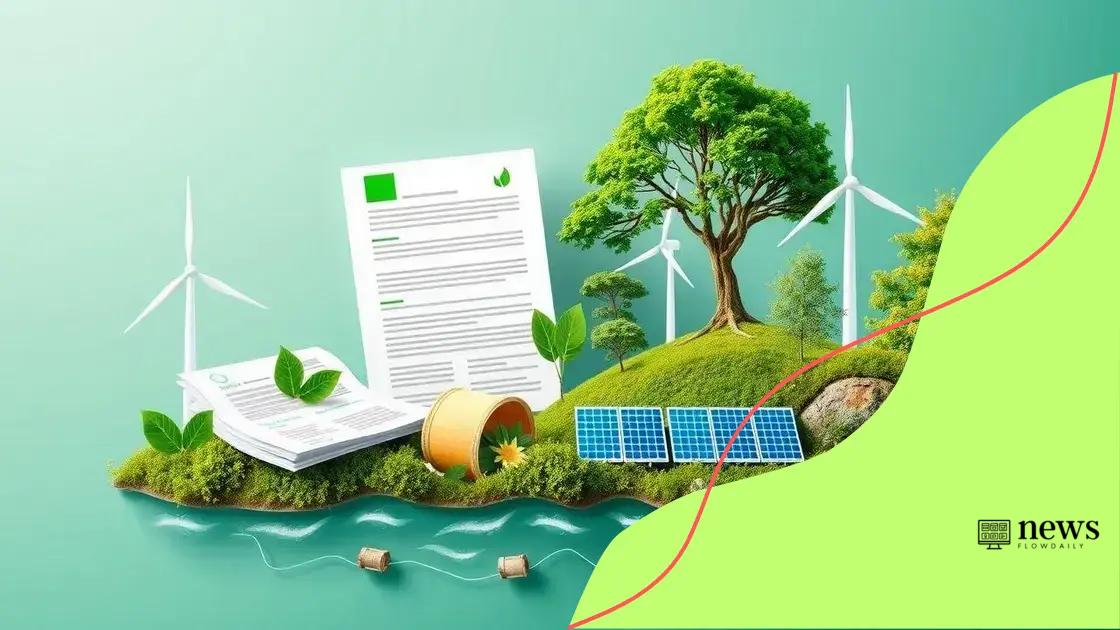Green bonds are financial instruments that fund environmentally friendly projects, promoting sustainability and reducing carbon emissions while offering competitive returns for investors.
Green bonds: financing a sustainable future is not just a buzzword; they’re a vital tool for funding sustainable projects. Have you ever considered how these bonds can help mitigate climate change and boost eco-initiatives in your community? Let’s dive into this transformative financial instrument.
What are green bonds?
Green bonds are specialized financial instruments designed to fund environmentally friendly projects. They provide a way for investors to support sustainable development while earning returns. This innovative financing mechanism has gained popularity due to the global focus on climate change and environmental sustainability.
Understanding Green Bonds
When you invest in green bonds, your money goes directly to initiatives that benefit the environment. These may include renewable energy, energy efficiency, or sustainable waste management projects. By issuing these bonds, organizations can raise funds while contributing positively to ecological goals.
Key Features of Green Bonds
- Dedicated to environmental projects.
- Attracts eco-conscious investors.
- Typically offer competitive returns.
- Regulated by specific standards to ensure environmental benefits.
Moreover, the market for green bonds has seen significant growth in recent years, indicating increased investor interest. This rise showcases a collective commitment to creating a sustainable future. Investors can feel good knowing their funds are helping to tackle serious challenges like climate change.
Another important aspect is the transparency that comes with green bonds. Issuers are required to report on the environmental impact of the projects funded by these bonds. This accountability builds trust with investors and assures them of the bond’s green credentials. As the demand for sustainable investing rises, green bonds are positioned as a vital tool in the global financial landscape.
In summary, green bonds play a crucial role in financing projects that foster a more sustainable future. They help bridge the gap between financial performance and social responsibility, offering a win-win for both investors and the environment.
The benefits of investing in green bonds
Investing in green bonds offers a range of benefits that appeal to a growing number of conscious investors. These bonds not only provide financial returns but also support significant environmental initiatives. By choosing to invest in green bonds, individuals can contribute to sustainable projects while potentially boosting their investment portfolio.
Financial Returns
One of the prime advantages of green bonds is their competitive financial performance. Many of these bonds offer yields comparable to traditional bonds, making them an attractive option for investors seeking both profits and sustainability. In fact, as the demand for eco-friendly investments grows, so does the interest from institutions keen on financing these projects.
Environmental Impact
- Funds renewable energy projects.
- Supports conservation efforts.
- Promotes sustainable agriculture.
- Encourages energy efficiency improvements.
When you invest in green bonds, you’re helping to finance initiatives that tackle pressing environmental issues. This could mean funding solar energy plants or improving water management systems. Investors can feel proud knowing their money is making a positive impact.
Another important aspect is the appeal to socially responsible investors. Many people today want their investments to align with their values. By putting money into green bonds, investors can back projects that mirror their commitment to sustainability and the environment. This alignment can enhance investor satisfaction and encourage long-term loyalty.
Additionally, the growing market for green bonds reflects a positive public perception, leading to increased credibility for businesses that issue them. As more companies choose to go green, investors are likely to see an expanding array of choices within the green bonds market.
How green bonds contribute to sustainability

Green bonds are essential tools in the fight for sustainability. By funding environmentally friendly projects, they provide a direct route for investors to make a positive impact on the planet. Their growing popularity is a testament to their effectiveness in channeling financial resources toward sustainable development.
Financing Sustainable Projects
One of the main ways green bonds contribute to sustainability is by financing critical projects that aim to reduce carbon emissions. These projects often include renewable energy sources like solar, wind, and hydropower. When investors purchase these bonds, they help bring innovative technologies to life, leading to a cleaner environment.
Encouraging Corporate Responsibility
- Helps corporations meet sustainability goals.
- Promotes transparency in environmental impact.
- Encourages the adoption of greener practices.
- Increases stakeholder trust.
Furthermore, green bonds encourage corporations to take responsibility for their environmental footprint. By offering a way for businesses to raise capital for sustainable initiatives, they promote a culture of accountability. As more companies issue green bonds, they motivate others to follow suit, leading to a broader impact on sustainability practices across industries.
Moreover, the clear guidelines and reporting requirements associated with green bonds help ensure the funds are used appropriately. This transparency reassures investors about the environmental impact of their investments. It builds a solid foundation for sustainable finance and fosters long-term commitment from both issuers and investors.
In addition to enhancing investor confidence, green bonds signal to the market that environmental concerns are becoming a priority. As awareness of climate change grows, these bonds play an essential role in driving change within the financial sector. They demonstrate that sustainability is not just a trend but a crucial aspect of modern investing.
Challenges in the green bond market
The green bond market has experienced significant growth, but it faces several challenges that can impact its effectiveness. These challenges can deter investors and slow the progress of funding sustainable projects. Understanding these issues is crucial for anyone interested in navigating this financial landscape.
Market Transparency
One primary challenge in the green bond market is the lack of uniform standards and transparency. Investors often struggle to determine which projects qualify as genuinely ‘green.’ Without clear criteria, it can be hard for them to assess the environmental impact of their investments.
Limited Awareness and Understanding
- Investors may not fully understand the benefits of green bonds.
- There is a knowledge gap among potential issuers about how to create green bonds.
- Many investors still view green bonds as riskier investments.
- Potential issuers may be unsure about how to align projects with green criteria.
This lack of awareness can limit participation in the green bond market. Educating both investors and project developers is essential to expand the market. With more information, they can make informed decisions and feel confident about their investments.
Another significant problem is regulatory complexity. The rules that govern the issuance of green bonds can vary widely by region. This inconsistency can create barriers for issuers looking to attract international investors. As companies aim to meet various regulatory requirements, it can become overwhelming.
Additionally, the potential for ‘greenwashing’ remains a concern. This term refers to when companies exaggerate the environmental benefits of their projects to attract investors. To combat this, the green bond market needs robust auditing and verification processes to ensure that funds are genuinely allocated to sustainable initiatives.
Future trends in green financing
The landscape of green financing is evolving rapidly, presenting exciting future trends that could reshape how we view investment in sustainability. As environmental awareness grows, so does the demand for innovative financial solutions aimed at tackling climate issues. Understanding these trends can benefit both investors and companies looking to engage in sustainable practices.
Increased Demand for Green Bonds
In the coming years, the demand for green bonds is expected to rise significantly. Investors are becoming more conscious of their impact on the environment and are keen to support projects that promote sustainability. This trend will likely encourage more companies to issue green bonds, leading to an influx of capital for renewable energy, conservation, and other eco-friendly initiatives.
Integration of Technology
- Use of blockchain for increased transparency.
- Artificial intelligence in assessing project viability.
- Mobile platforms for easier investment.
- Data analytics to measure environmental impact.
Advancements in technology will also play a crucial role in the future of green financing. Tools like blockchain can enhance transparency and traceability of funds, ensuring they are used for intended projects. Additionally, artificial intelligence can help assess the viability of green initiatives, guiding investors toward sound decisions.
Moreover, mobile platforms will likely make it easier for everyday investors to participate in the green financing market. By simplifying access, more individuals can contribute to sustainable projects, democratizing the investment landscape.
As sustainability becomes a core aspect of corporate strategy, more companies will prioritize eco-friendly practices. This shift will create a positive feedback loop in green financing, attracting investors while helping businesses establish a trustworthy reputation.
Furthermore, collaboration among governments, firms, and NGOs will intensify, creating frameworks for sustainable finance. These partnerships are vital for establishing guidelines that help mitigate risks associated with investing in green projects, ensuring long-term viability.
In summary, investing in green bonds presents an exciting opportunity to support sustainable initiatives while achieving financial returns. As this market continues to grow, challenges such as transparency and regulation must be addressed. In the future, advancements in technology and an increase in collaboration among stakeholders will enhance the effectiveness of green financing. The overall commitment to sustainability will create a positive impact on the environment, benefiting communities and investors alike.
FAQ – Frequently Asked Questions about Green Bonds
What are green bonds?
Green bonds are financial instruments designed to raise funds for environmentally friendly projects that promote sustainability.
How do green bonds contribute to sustainability?
They provide financing for renewable energy, conservation, and other eco-friendly initiatives, helping to reduce carbon emissions.
What challenges does the green bond market face?
The market struggles with lack of transparency, regulatory complexity, and potential for greenwashing, impacting investor confidence.
What trends are expected in green financing?
Increased demand for green bonds, integration of technology, and enhanced collaboration among stakeholders will shape the future of green financing.


 InvestmentPlatforms: Unlocking financial potential today
InvestmentPlatforms: Unlocking financial potential today  Maximize Your 401(k) Contributions in 2025: A Complete Guide
Maximize Your 401(k) Contributions in 2025: A Complete Guide  Maximize Your 401(k) in 2025: A Guide to the $23,000 Limit
Maximize Your 401(k) in 2025: A Guide to the $23,000 Limit